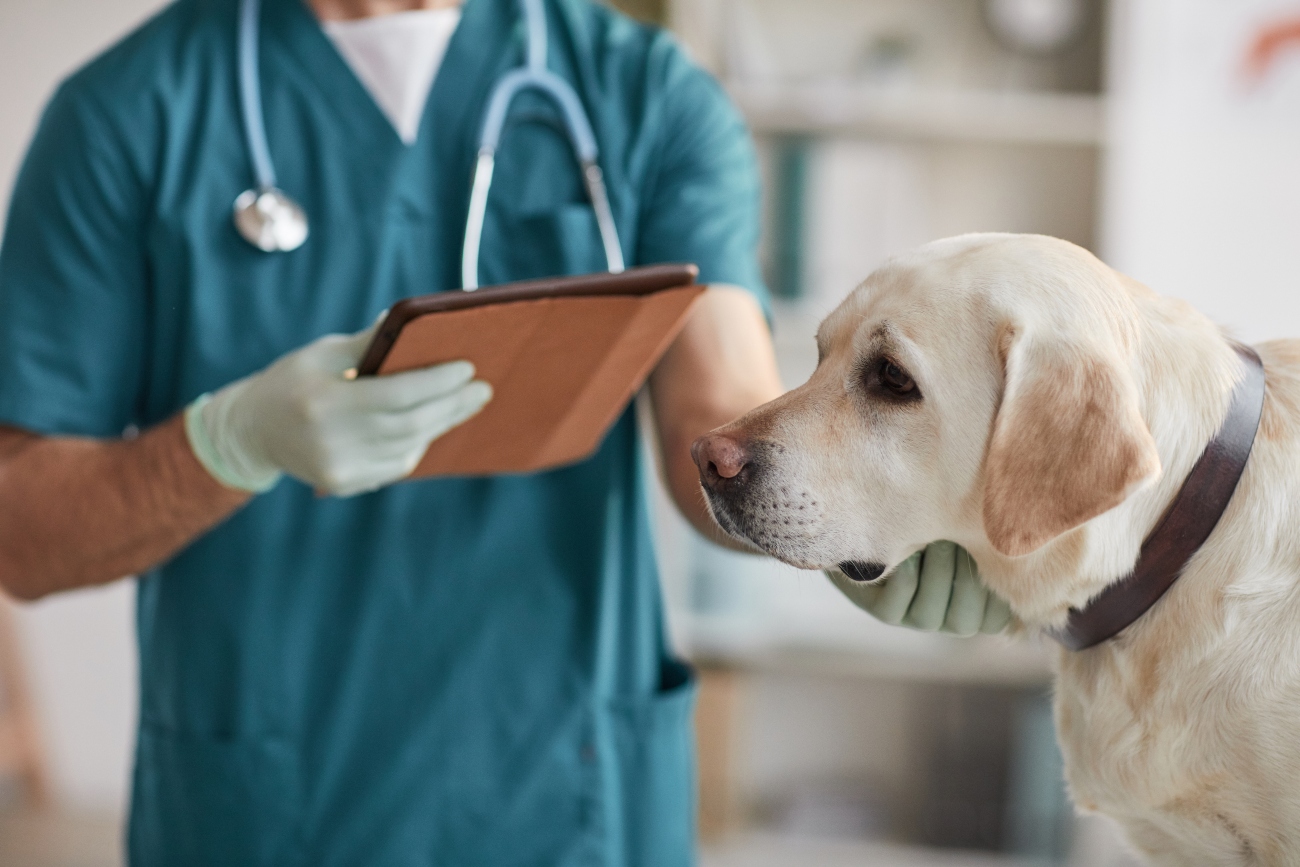
What are the signs of diabetes in older dogs?
24th February, 2022
It may be best known as a condition that affects humans, but diabetes can afflict our canine companion, too. Studies have shown that some dog breeds are at greater risk of developing the condition than others. We'll look into the more susceptible breeds a little further down this article.
More generally, though, any dog that becomes obese, whether male or female, will be at greater risk of becoming diabetic. This problem also becomes more acute later in life: older dogs will be at a slightly higher risk of developing diabetes than young pups.
As we will see, the good news is that, although canine diabetes cannot be cured, it can be effectively managed. If given the right medication, there’s no reason why a diabetic dog should not continue to live a happy, normal, active life.
There will be costs involved in both diagnosis and, especially, in the ongoing treatment of the condition. To protect yourself against unexpected vet bills, you should consider some pet insurance for older dogs, to help safeguard your beloved pet's health in their later years.
Read on as we reveal the science behind canine diabetes, plus how it might affect your pet – and how you can keep on top of the condition.

What is canine diabetes?
Let's begin with a definition. Like its human counterpart, canine diabetes develops when the body stops making insulin. This hormone is essential for allowing glucose to enter the body's cells and produce energy.
So, essentially, glucose remains in the blood, rather than being absorbed into the areas of the body that need it. That means that blood sugar levels are too high, while key areas of the body aren't able to function properly.
Dogs suffering from diabetes may lose weight – they will also drink more and urinate more often.
When a dog becomes diabetic, either their pancreas is not producing enough of the hormone insulin – essential for the absorption of glucose from the bloodstream into cells – or their body is not responding to that insulin as it should. Without the insulin, the body cannot absorb the glucose from the bloodstream, and move it around the body to the various cells that need it in order to survive and grow.
Essentially, a diabetic dog will not be able to control the levels of sugar in its blood. If these levels get too high (hyperglycaemia), problems can arise. In fact, a lot of dogs can manage with hyperglycaemia for a certain amount of time.
Problems are most likely if they then develop another illness – a urine infection, for example. The combination of the two conditions can make them seriously unwell. Added to this, diabetic animals are more prone to suffer from other health problems.
Relatively common in dogs, diabetes is unfortunately not preventable. It can, however, be treated, although it is relatively expensive. However, as we mentioned, some suitable pet insurance for older dogs may be able to help with the costs of treatment.
And that treatment is definitely required. Quite apart from the pain and difficulties it can impose on your dog, dog diabetes can, if left untreated, bring about a number of other health issues.
Are there different forms of canine diabetes?
Any dog that develops diabetes will most likely suffer from the Type 1 form of the disease. But what does that actually mean?
Just as in us humans, Type 1 diabetes means that the body is not producing insulin. That means that your dog will depend on insulin treatments for life. We'll get a little deeper into how the insulin is administered further down this article.
In cases of the much rarer Type 2 diabetes, the dog’s pancreas is producing some insulin, in contrast with Type 1. However, it's either being produced in insufficient quantities, or the body is not responding to it properly.
Another form of diabetes, rarer in dogs, is diabetes insipidus. This disorder affects your canine’s ability to retain water. A dog with diabetes insipidus will drink excessive amounts of water, as they try to replace all the water they are losing through urination.
Why do dogs get diabetes?
The precise reason that dogs get diabetes is not fully understood. However, there are a few contributing factors that seem to make it more likely to develop. These include:
Breed
As with many conditions, some dog breeds do appear to be more predisposed than others. These breeds include Poodles, Bichons frisés, Samoyeds, and Miniature schnauzers. Dachshunds, Australian terriers and standard schnauzers are also at risk.
Age
Diabetes is most often observed in dogs aged five or over. Middle aged and senior dogs are most at risk. Diabetes is just one of a series of illnesses for which risk factors increase as dogs grow older: others include heart problems, gastrointestinal issues and dementia. We've discussed dementia in pets, and called for it to be more widely recognised, elsewhere on our blog.
The increased risk of these various diseases as your beloved dog gets older makes a compelling case for some specialist pet insurance for senior dogs.
Pancreatitis
In this condition, the pancreas becomes inflamed, reducing its ability to produce insulin. Diabetes often follows on from this insulin shortfall. The PDSA website has a helpful page with information all about the diagnosis and treatment of pancreatitis.
Neutering status in females
Unneutered female dogs seem more likely to develop Type 2 diabetes, specifically, than neutered females. This is because the female hormones can result in cells becoming resistant to insulin.
Being overweight
Diabetes is often linked with obesity. In fact, the precise nature of the link between excess weight and canine diabetes is not quite clear. What we can say with certainty is that obesity will leave dogs more vulnerable to certain other conditions, such as pancreatitis – which in turn can lead to diabetes.
We discussed recently how evidence suggested that many UK pets had put on weight during lockdown. It's always important to monitor your dog's weight and make sure they are keeping within a healthy weight range. The RSPCA website contains some useful background and advice on treating obesity in pets.
Steroids
There seems to be some link between diabetes and steroids – either those given as a medication, or produced in excess in conditions such as Cushing’s disease. This is because steroids can also result in resistance to insulin. We explain more about Cushing's disease, in which the body produces too much of the steroid hormone cortisol, elsewhere on our blog.
What are the signs and symptoms of canine diabetes?
Diabetes in dogs typically brings with it a set of signs and behaviours that most owners should be able to recognise. You may pick up some of these signs and suspect the onset of diabetes in your dog: if you do, your next step should be to visit your vet for a professional diagnosis.
If you have pet insurance for older dogs through Petwise, you can call the dedicated 24-Hour Vet Helpline. This advice line is available to all new and renewing Petwise customers, who are entitled to unlimited usage. The line offers access to UK veterinary nurses, who are on hand to help you with any pet-related queries.
Signs of diabetes in dogs include:
- Increased urination. Your dog will need to pee more often. The reason for this is that that excess, unabsorbed glucose draws water with it into the urine.
- Excessive thirst. Your dog will also need to drink more, because all that extra urination will mean a lot of fluids are being lost.
- Increased hunger.
- Weight loss. Without insulin to allow those essential sugars into the body, those important sugars are lost in their pee. Your dog then isn't getting enough calories from food for their daily needs, so the body starts to break down its fat reserves. Result: abnormal weight loss. Learn more about the reasons behind your dog rapidly losing weight in our recent blog.
Essentially, if a dog develops diabetes, the signs should be quite clear and obvious, with a dramatic change in their appetites (for both food and drink) and an increased frequency in their visits to the toilet.
There are some other symptoms associated with diabetes, too, including sweet smelling breath, a general lethargy and lack of interest in what's happening around them, and a propensity for skin and urinary infections. Diabetic dogs may also vomit regularly.

How will a vet diagnose diabetes?
If they suspect diabetes, your vet's first step will be to take a blood test from your dog. If the test shows unusually high levels of glucose in the blood and urine, and if these levels are coupled with the symptoms and behaviours we ran through above, it's quite probable that your dog has developed diabetes.
Just to make sure, your vet may also perform a test for fructosamine levels in the blood. This test helps to measure blood sugar levels over a longer period of time. This can give a more reliable result as glucose levels can fluctuate throughout the day – or at times of stress, for example.
What medication does a diabetic dog need?
A diabetic dog will require extra insulin – either to compensate for the lack of this hormone, as seen in Type 1 diabetes, or the inefficient use of it in Type 2. Insulin is injected into the bloodstream: your vet will be able to show you how to do it, and after that you will perform the injections yourself.
Now, this probably sounds a little frightening – for both you and your dog! – and it may take a few days to feel at ease with the routine. However, many dog owners around the UK manage their pet's insulin injections without problems.
Indeed, the needles used are small – and many dogs won't even notice that they are being injected. There's a helpful how-to video on injecting your dog with insulin on the PDSA website.
These insulin injections must be given twice a day at set times, 12 hours apart. You should not give a dog insulin within an hour of feeding. Instead, administer the injection while your dog eats, or – even better – just before eating.
You can buy the insulin yourself, either at a chemist or online. You don't need a prescription, but it should only be given once your vet has made a positive diagnosis of diabetes. Insulin is relatively expensive, but you may be eligible for some help with the costs from your provider of pet insurance for older dogs.
Your vet may also recommend that you carry out regular tests of your dog's blood glucose levels. Again, this is a relatively simple procedure: it just involves using a tiny pin prick to take a small swab of blood.
It's very important to stick to the routine you've been given, and to give your dog their insulin injections at the same time each day. Your vet will probably also recommend a suitable food regime for your dog – both specific foods, and controlled amounts – and you should make sure that you stick to this, too.
Another precaution you should take with a diabetic dog is to clean their teeth regularly. The reason for this is that any oral infections can cause blood sugar levels to rise, which can be dangerous for diabetic animals. You may wish to find some pet insurance for older dogs that includes dental cover as standard – it's something that we are proud to offer here at Petwise.
How important is diet in managing diabetes?
A balanced diet, with suitable amounts of the correct foods, will prove enormously useful in keeping your dog’s blood sugar levels safe, and in maintaining their quality of life generally.
Once again, take care to stick to your vet's advice on what to feed your dog – and in what quantities. Also follow any advice on when meals should be taken, and when injections should be administered.
Diabetic dogs are often put on high-fibre diets, as fibre can play a key role in limiting increases in blood sugar. Avoid giving your dog any human snacks, as they may adversely affect their glucose levels.
What are the long-term impacts of diabetes?
Although diabetes is a serious condition, and is also incurable, the outlook for your dog need not be bleak at all. As long as they are properly medicated and follow a suitable diet, most diabetic dogs are relatively unaffected by the problem, and are able to lead happy, healthy and active lives.
However, diabetes will leave dogs more prone to certain other conditions. For example, a dog's eyes are affected by the fluctuating levels of sugar, and they may develop cataracts – where the lens of the eye becomes clouded, rather than clear, meaning vision becomes impaired. These cataracts, if left untreated, can eventually lead to the dog becoming totally blind.
We've written a longer article, elsewhere, discussing some common signs that your dog's eyesight is deteriorating. Essentially, you will have a choice whether or not to get the cataracts operated on. This will be an expensive procedure, although your pet insurance for older dogs may be able to help with the costs.
Alternatively, you can choose not to intervene. Indeed, many dogs manage very well without sight. This will be particularly true if your dog's breed is one of those with a particularly strong sense of smell. These super-sniffers include Basset hounds, Bloodhounds, German shepherds, Labradors and Springer spaniels.
Urinary tract infections (UTIs) are also a fairly significant risk factor for diabetic dogs. The reason for this is that the excess sugar in the urine makes an ideal breeding ground for the bacteria that cause these infections. UTIs can be painful for dogs, and they can also lead to kidney problems and to bladder infections. For these reasons, it's important to treat any UTIs quickly.
Treatment for UTIs begins with taking a urine sample, which you may either do at home or at the vet's. After that, your dog will be prescribed a course of antibiotics, typically lasting either seven or 14 days. You should also encourage them to drink plenty of water during this time.
Other senior dog health problems with similar signs
In fact, the range of symptoms that can indicate diabetes can also apply to a number of other illnesses.
Cushing’s disease
Also known as hyperadrenocorticism, this is a serious health condition in dogs. It occurs when the adrenal glands overproduce cortisol in the body. This surplus can increase a dog's risk of various serious conditions, including kidney damage – and diabetes itself.
Symptoms of the condition include excessive drinking and urination, plus bald patches and a pot belly. Thankfully, treatment is straightforward: dogs are given daily medication to reduce the amount of cortisol they are producing. Once they are on a course of treatment, the outlook for a dog with Cushing’s is generally good. The disease can affect most dog breeds, but is commonest in middle-aged dogs. You can find a comprehensive guide to the condition, and its treatment, on the PDSA website.
Kidney disease
Also called renal disease, this umbrella term basically describes any condition that prevents the kidneys from working properly. This can be serious because kidneys are hugely essential organs that work very hard to keep our pets healthy.
Their important duties include flushing out waste from the body, via the urine; removing toxins from the blood; preventing animals from losing too much water; and maintaining their blood pressure at a healthy level.
Signs and symptoms of kidney disease resemble those for diabetes, and include increased thirst and urination. Your dog may look unwell, and may vomit. They may go off their food and lose weight; and all this stress on their body is likely to make them tired, listless and unhappy.
Addison's disease
Also called hypoadrenocorticism, this is in fact a similar condition to Cushing's disease above – but the exact opposite is happening. In this case, the adrenal gland is producing too little, rather than too much, of some essential hormones – namely cortisol and mineralocorticoids, which help to regulate water and salts. Common signs include reduced appetite, weakness and lethargy, and weight loss. You may also observe vomiting, diarrhoea, and shaking.
Hypothyroidism and hyperthyroidism
This is another pair of similar yet opposite conditions. In hypothyroidism, the thyroid gland doesn't produce enough of a key hormone, with results including lethargy, weakness, weight gain and hair loss. The condition can be managed, once a vet has diagnosed the problem.
Conversely, hyperthyroidism involves the thyroid producing too much of a certain hormone. Symptoms here include increased hunger with weight loss, hyperactivity and sickness.

How can dogs help humans with diabetes?
Here’s an interesting – and heartwarming – final chapter to the story of dogs and diabetes. It turns out that, when they are given suitable training, some dogs can learn to recognise when humans' blood sugar levels have got either too low or too high.
These dogs, known as 'Hypo Hounds' (a 'Hypo' is the informal name for an episode of hypoglycaemia, or dangerously low blood sugar levels) are trained to detect changes in blood sugar in their Type 1 diabetic owners. By doing this, and alerting their owners or families, Hypo Hounds are helping to prevent potentially life-threatening hypoglycaemic episodes.
The dogs can also be trained to recognise when blood sugar levels get too high, as they do in Type 1 diabetes, or hyperglycaemia. Many Hypo Hounds work with diabetic children, and play a huge role in helping the latter to gain their own freedom and independence.
Pet insurance for older dogs from Petwise
Diabetes can be a costly condition to manage. That’s why pet insurance for older dogs is so important. Contact us today to arrange a quote.